#lyakhovsky islands
Explore tagged Tumblr posts
Video
tumblr
An incredible update on the bear mummy I shared back in 2020 x
Originally reported as a mummified cave bear, genetic testing has shown the remains are in fact those of an approximately 3,500 year old brown bear ("Genetic analysis has shown that the bear does not differ in mitochondrial DNA from the modern bear from the north-east of Russia." - Maxim Cheprasov, Lazarev Mammoth Museum Laboratory).
The specimen, now dubbed the “Etherican brown bear”, was discovered by reindeer herders back in 2020 on Bolshoy Lyakhovsky Island, located in the East Siberian sea. The recent necropsy showed the bear to be a young female, likely between two and three years old at the time of her death, and that she was killed by an injury to her spinal column.
sources x x
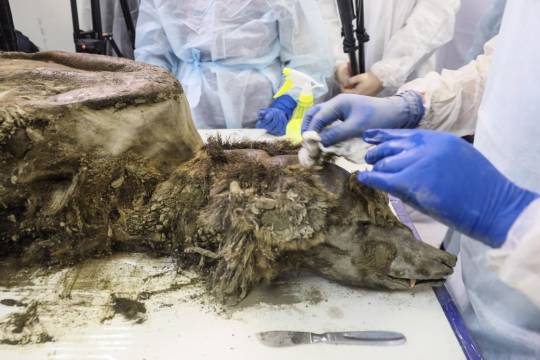
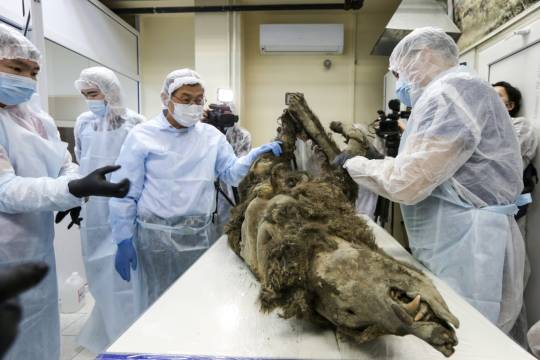
#palaeoblr#palaeontology#Yakutia#Siberia#Pleistocene#ice age#permafrost#ice age mummy#East Siberian brown bear#brown bear#ursidae#bearposting#upload
66 notes
·
View notes
Photo

What remains to be discovered The animal's brain was also removed, after a cut was made in the skull, and should be studied in the future. One of the biggest mysteries for now is how the bear got to the Siberian island of Great Lyakhovsky, which is 50 kilometers from the mainland. The most plausible explanation, for now, is that the brown bears came to the archipelago when it was still connected to the mainland by the freezing of the sea, at the Last Glacial Maximum. The problem is that, in this case, more bear remains would have been found by scientists on trips to the island. Other paleontological treasures have already been found there, such as the remains of woolly mammoths. https://www.instagram.com/p/Cp-1H8bjQlk/?igshid=NGJjMDIxMWI=
0 notes
Text
A 3,500-year-old bear preserved in Siberian permafrost is dissected by researchers - best2daynews
A nearly 3,500-year-old brown bear that was nearly perfectly preserved in Siberian permafrost is now being dissected by Russian researchers. The female bear has undergone a necropsy after it was discovered by reindeer herders on Bolshoy Lyakhovsky Island in the Arctic in 2020. It was found just east of the Bolshoy Etherican River and, therefore, has been named the Etherican brown bear. The…

View On WordPress
0 notes
Text
And we all know how Captain Caveman came out emerging from glacial ice of some four millennia back....
0 notes
Text
Siberian History (Part 1): Geography of Siberia
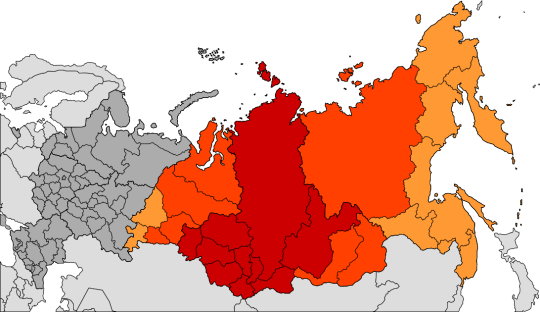
Red: Siberian Federal District
Red & dark orange: Geographic Russian Siberia
Red & both oranges: North Asia (greatest extent of Siberia); Historical Siberia (and present Siberia in some usages)
The topography of Siberia can be divided into three main zones: 1) In the north is a great treeless tundra, extending along the whole Arctic coast; 2) the middle zone is a broad belt of forest, from the Ural Mountains to the Sea of Okhotsk; 3) the southern zone is arable land that gradually becomes semi-arid desert steppes, stretching from the southern Ural Mountains to beyond the Mongolian border.
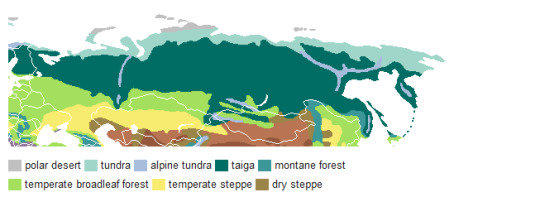
Tundra
In a tundra environment, low temperatures and short growing seasons hinder tree growth. ��The vegetation is mostly dwarf shrubs, sedges, grasses, mosses and lichens. Scattered trees do grow in some regions. There are three types of tundra (Arctic, alpine and Antarctic), and the Siberian tundra is mainly Arctic tundra. (Alpine tundra grows on mountains all around the world, including in Siberia.)
The tundra is dry, inhospitable and desolate. For most of the year, it is covered in trackless snow. Tufts of coarse grass, and swards of moss & lichen, grow on it, but not much else. Fierce Arctic gales called purgas force the snowy surface into long, hard, fluted waves (by drifting, packing and scoring it).
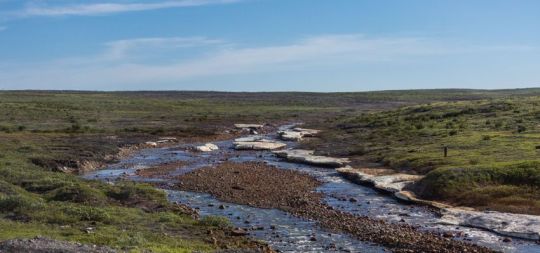

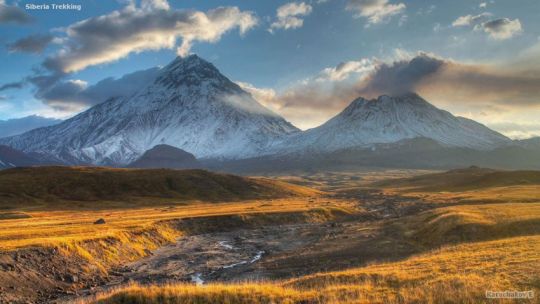
Siberian tundra.
Beneath the surface is permafrost, a thick substratum of “geological ice”, very deep in places. In summer, the surface thaws only to a shallow depth, and beneath that the ground is hard and impervious to water. Evaporation is the only way water can escape, as it cannot drain downwards.
Melting snow saturates the topsoil, and therefore over time it has become covered with a dense layer of grey Arctic moss. Moss grows out of decaying moss, year after year, and the whole tundra has become a huge spongy peat bog.
The boundary region between the tundra and the taiga zone is called the tree line or timberline. Here, along the tundra's southernmost margins, some trees grow. The soil is shallow and they tend to grow extremely sideways. Many trees become gnarled and twisted from straining towards the meagre Arctic light. Some twist in upon themselves.
In early summer, the meltwater collects into perfectly round lakes. Stones are squeezed to the surface, forming neat concentric circles, with the larger stones on the outside and the smaller ones inside.
The soil contracts from low temperatures, and becomes brittle enough to crack. During spring, meltwater trickles into the cracks and frost fissures, and later freezes into ice wedges, breaking the soil into even-sided polygons.
The tundra wildlife is limited – reindeer, polar bears, Arctic foxes and lemmings.
Taiga
A taiga environment (also called boreal/snow forest) is characterized by coniferous forests, mostly made up of pines, spruces and larches. The Russian taiga has all three of these types of trees, but the eastern Siberia tundra is basically a huge larch forest.

Dahurian larch trees in the Kolyma region of north-eastern Siberia.
The Siberian taiga begins about 320 – 640km inland from the northern coast. First there are scattered larches, struggling to find patches of thawed ground. Then, by degrees, there are denser stands of pine, fir, spruce, cedar and birch. Their intertwining branches eventually form a thick canopy above the forest floor. Even at noon, the heart of the taiga is bathed in twilight.
The wildlife of the taiga is very diverse – brown & black bears, wolves, wolverines, wild boar, badgers, lynxes, elks, polecats, stoats, squirrels, sables (a species of marten) and hares. There are hundreds of species of birds, including ducks and geese.
Steppe
Eventually, the taiga becomes a mixed forest zone of poplars, elms, maples, aspens and limes. This mixed forest zone then thins out towards the southern steppes, which are rich in arable land and pastureland. In some places, the western Siberian steppe is as fertile as the black soil of Ukraine.
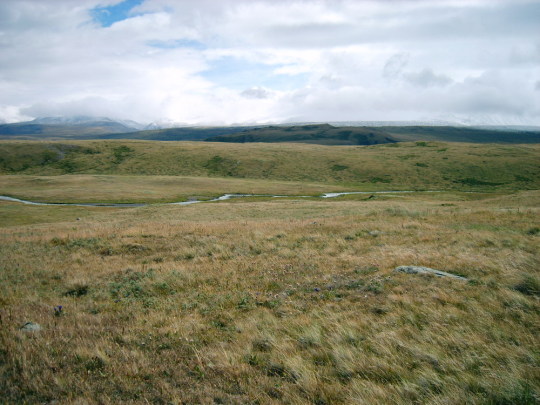
Ukok Plateau, part of the mammoth steppe in Siberia and Mongolia.
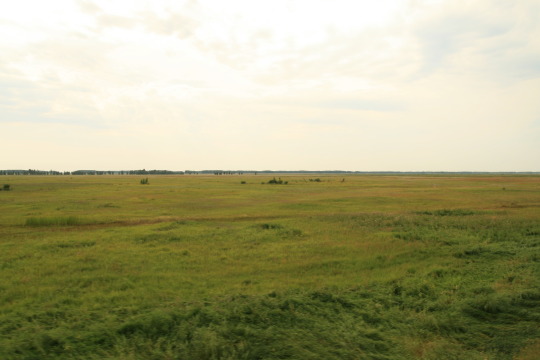
The steppe of south-western Siberia.
On its margins, it turns to sand. For about 3,200km, southern Siberia skirts a “land of summer snow”, where thick salt deposits lie beneath the desert sun.
Temperature-wise, Siberia goes to extremes. Winters are severe, but the brief summers can be extremely hot, even in the upper latitudes.
Mountains
There are several great mountain ranges in Siberia – the Altai Mountains, Sayan Mountains, Yablonoi Mountains, Stanovoy Range, Verkhoyansk Range, and the volcanoes of Kamchatka Peninsula.

The Altai Mountains are located in Central and East Asia, where the borders of Russia, China, Mongolia and Kazakhstan come together. This is also where the Irtysh and Ob Rivers have their headwaters. The Altai Mountains merge with the Sayan Mountains in the north-east. In the south-east, they gradually become lower, and merge into the high plateau of the Gobi Desert.
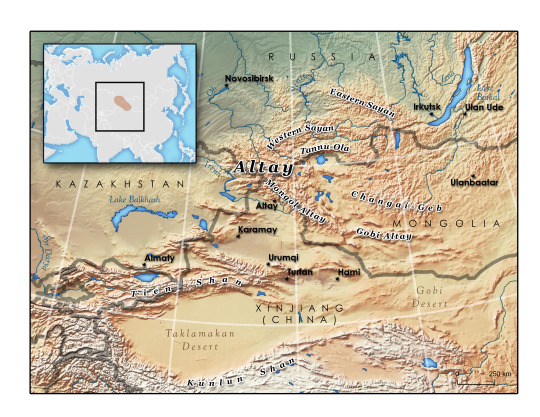
The Sayan Mountains are located in southern Siberia, Russia, and northern Mongolia. They formed part of the border between Russia and Mongolia in the past. This is where the tributaries begin that eventually merge to become the Yenisei River.
The Eastern Sayan Mountains stretch 1,000km from the Yenisei River to the south-west end of Lake Baikal. The Western Sayan Mountains form the eastern continuation of the Altai Mountains.
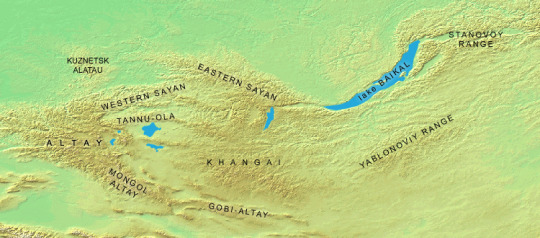
The Yablonoi Mountains begin in Mongolia and extend north-east into Siberia. They pass just east of Lake Baikal, and are about 1,600km long. These mountains form the divide between the rivers that empty into the Arctic and Pacific Oceans. They can be considered a south-western extension of the Stanovoy Range.
These mountains are found in the Transbaikal, a mountainous region east of Lake Baikal. They divide the Transbaikal into two great terraces of almost equal size.
The Stanovoy Range runs south-west to north-east for over 900km, stretching from the Olyokoma River to the Uchur River. In the past, it served as the border between Russia and China; and it divides the watersheds of the Arctic and Pacific Oceans. Many glaciers, the main source of the Lena River, can be found in these mountains.
The Verkhoyansk Range forms a huge arc between the Lena and Adan Rivers (to the west) and the Yana River (to the east). It is parallel to the Lena River.
The Kamchatka Peninsula is divided by a spine of volcanic summits that form a nearly-continuous ridge. The Klyuchevskaya Sopka is the tallest mountain in Siberia at 4,750m.

Along the whole eastern coast of Siberia, various ranges break off into the sea in shattered headlands and cliffs. In the past, they were broken off from mountain ranges on the Northwestern Pacific Coast of the USA, by cataclysms such as earthquakes and volcanoes. Between these two coasts are chains of volcanic islands with bare, steep coasts that appear similarly sundered and torn.
Rivers
Siberia's three great rivers that flow into the Arctic Ocean are the Ob, Yenisei and Lena Rivers. They are formed in the mountains of Southern Siberia, the glaciers of the Altai Mountains, and the borderlands of Mongolia. They give off many tributaries to the east & west, and flow northwards towards the Arctic.

The Ob River is the westernmost of these three rivers, and it is the seventh-longest river in the world. It forms where the Biya and Katun Rivers merge, in the Altai Mountains.
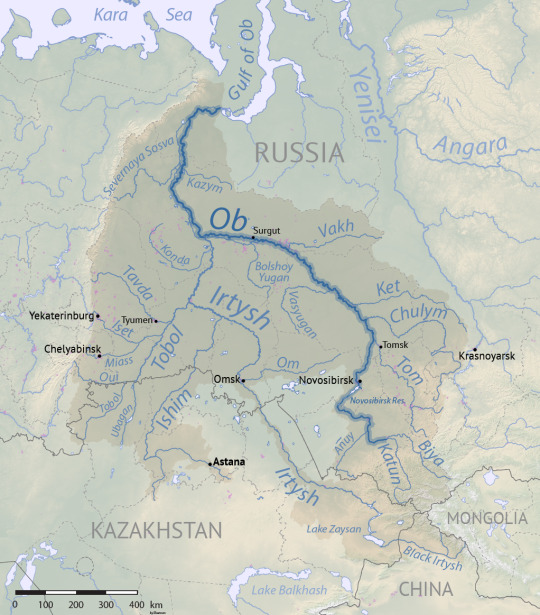
The Yenisei River is the middle river, the fifth-longest river in the world. It begins in Mongolia, and empties into the Yenisei Gulf in the Kara Sea (part of the Arctic Ocean).
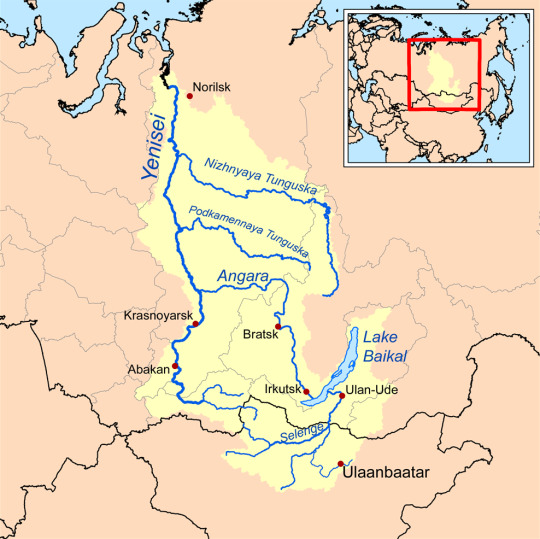
The Lena River is the easternmost river, the eleventh-longest river in the world. It is the longest river that is entirely within Russia, and begins in the Baikal Mountains south of the Central Siberian Plateau. It empties into the Laptev Sea (a marginal sea of the Arctic Ocean).

Siberia's fourth great river is the Amur River. It forms on the Mongolian Plateau south of Lake Baikal, and flows into the Pacific Ocean, between the Sea of Okhotsk and the Sea of Japan. The island of Sakhalin is located opposite the river mouth, and to the south & east of Sakhalin are the Kuril Islands.

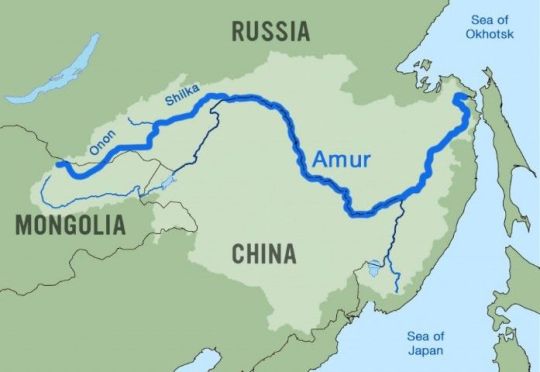
Other
Novaya Zemlya is an archipelago in the Arctic Ocean, and the easternmost point of Europe. It is made up of two islands – the Severny Island (north) and Yuzhny Island (south), separated by the Matochkin Strait. To the west is the Barents Sea, and to the east is the Kara Sea, where the Yenisei River ends.
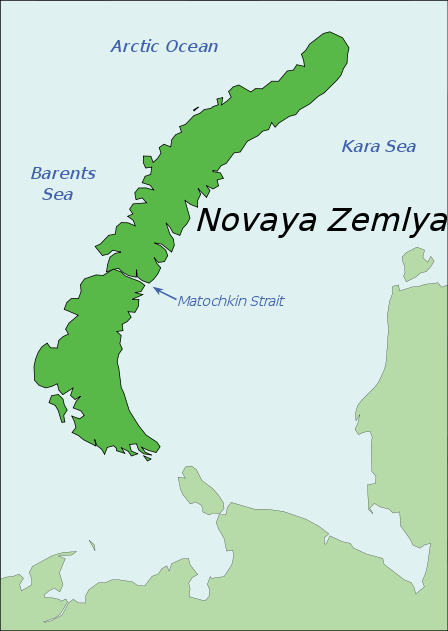
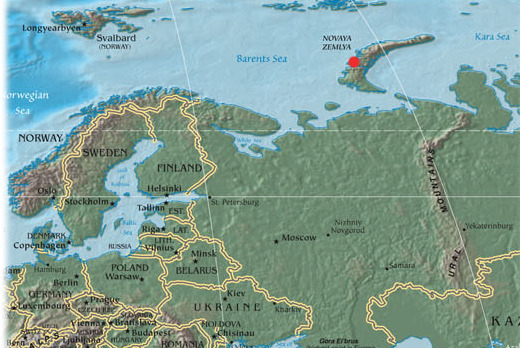
The Yamal Peninsula is part of the Yamalo-Nenets Autonomous Okrug in north-western Siberia. It is surrounded by the Kara Sea, with the Baydaratskaya Bay to the west and the Gulf of Ob to the east. At the northern end of the 700km-long peninsula is Bely Island, with the Malygina Strait separating them. In the Nenets language, “Yamal” means “end of the land”.
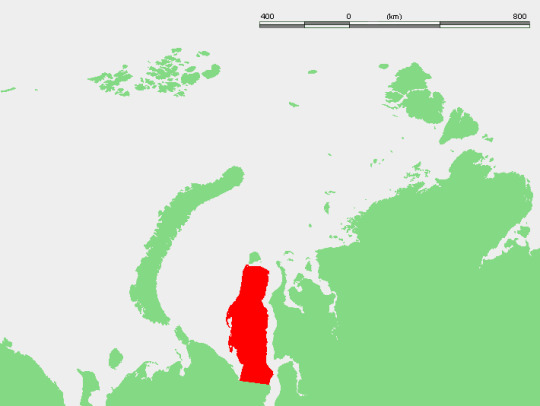
The Taymyr Peninsula is the northernmost extension of Eurasia.
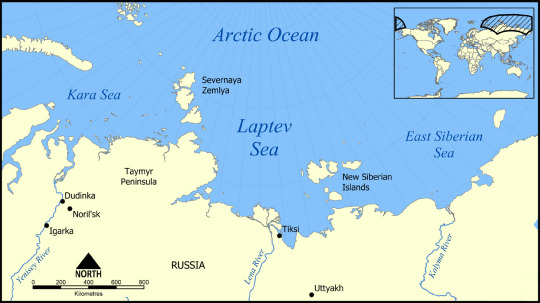

The New Siberian Islands are an archipelago in the Far North of Russia. They are north of the East Siberian Coast, with the Laptev Sea to the west and the East Siberian Sea to the east. The Lyakhovsky Islands are the southernmost group of the New Siberian Islands.
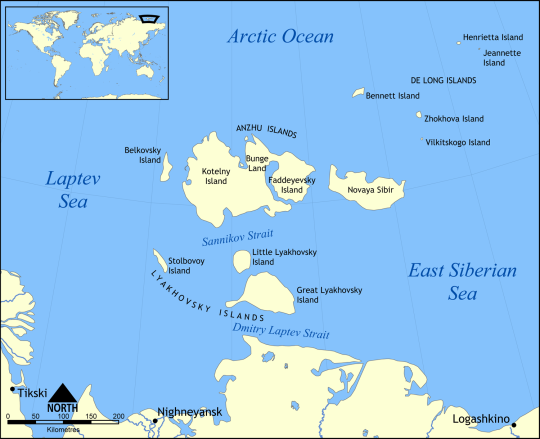
#book: east of the sun#history#geography#geology#russia#siberia#russian far east#russian far north#kamchatka peninsula#novaya zemlya#yamal peninsula#taymyr peninsula#new siberian islands#lyakhovsky islands#altai mountains#sayan mountains#yablonoi mountains#stanovoy range#verkhoyansk range#klyuchevskaya sopka#ob river#yenisei river#lena river#amur river
12 notes
·
View notes
Photo

Satellite view of the Lyakhovsky Islands, the southernmost group of the New Siberian Islands in Russia.
2 notes
·
View notes
Photo




kotelny island
#aesthetic#found aesthetic#google maps#google street view#kotelny island#russia#new siberian islands#lyakhovsky islands
1 note
·
View note
Photo

Work in progress underpainting for Ursus spelaeus, also known as a Cave Bear. Cave Bears were among the largest of Ice Age bear species, able to reach heights of 11.5 feet when rearing up on their hind legs, it's shoulder would have come up to an adult human's head, and large male specimens topping the scales at more than 1,300 pounds.
They had a habitat that ranged across Europe and Asia, and despite their fearsome appearance and size mostly fed on a plant based diet. U. spelaeus lived between 250,000 to 24,000 years ago. Their common name of Cave Bear, comes from the fact that many of their remains were found in naturally formed caves, judging from the large number of bones found at some sites, it is thought that they would at least sometimes use these caves as dens.
Recently, in Russia, the remains of what could be the first ever preserved corpse of a fully grown Cave Bear may have been discovered, it was discovered on Bolshoy Lyakhovsky island by a group of reindeer herders. There was also what looks to be the corpse of a preserved cub found on mainland Yakutia. The scientists are hopeful that one or more of these might yield DNA, there has been partial DNA discovered and sequenced from skeletal remains in the past.
https://siberiantimes.com/other/others/news/first-ever-preserved-grown-up-cave-bear-even-its-nose-is-intact-unearthed-on-the-arctic-island/
**It has been suggested to me that this discovery is very new and it may either be just the remains of a prehistoric Brown Bear or of another species of cave dwelling bear, Ursus deningeri kudarensis, the latter is likely based on the location of these new remains and the previously known ranges of U. spelaeus and U. deningeri kudarensis. In the end, more research is required for a definitive answer.
#workinprogress#wip#cavebear#iceage#bear#mammal#paleo#paleoart#paleontology#paleoartprocess#sciart#science#digitalart#digitalillustration#illustration#illustrationart#art#artist#educational#naturalhistory#prehistoric#maine#maineart#newengland#newenglandart#pleistocene#artistsontumblr
29 notes
·
View notes
Text
Ice Age Cave Bear Found Preserved in Permafrost on Siberian Island
https://sciencespies.com/news/ice-age-cave-bear-found-preserved-in-permafrost-on-siberian-island/
Ice Age Cave Bear Found Preserved in Permafrost on Siberian Island
Scientists at the North-Eastern Federal University in Yakutsk, Russia, announced on Saturday the discovery of a well-preserved cave bear on the New Siberian island of Bolshyoy Lyakhovsky, Anna Liesowska reports for the Siberian Times.
The adult bear lived its life sometime in the last Ice Age, at the same time as large animals like woolly mammoths, mastodons and saber-toothed tigers. When the bear died, permafrost preserved its soft tissues, organs and fur, making it the best-preserved example of a cave bear found yet. Most cave bear remains discovered so far have been odd bones and skulls.
Coincidentally, a preserved cave bear cub was recently found on the Russian mainland, the university says in a statement. Using the two discoveries, scientists hope to learn more about cave bears’ lives.
The whole, adult bear carcass is “the first and only find of its kind,” paleontologist Lena Grigorieva says in the university statement. “It is completely preserved, with all internal organs in place, including even its nose. This find is of great importance for the whole world.”
Reindeer herders working on the island discovered the ancient bear carcass and reported it to the university, which specializes in studying preserved Ice Age mammals.
The team identified it as a cave bear, a species of bear that’s now extinct. It’s last common ancestor with modern bears lived about 1.2 to 1.4 million years ago, according to a study published in the journal Current Biology in 2001, George Dvorsky reports for Gizmodo. Cave bears could weigh up to 1,540 pounds, which is larger than most polar bears. The cave bear carcass found on Bolshyoy Lyakhovsky probably lived between 22,000 and 39,500 years ago, and the researchers hope to narrow that window with further research.
The cave bear adult and cub are the latest additions to a growing list of preserved Ice Age carcasses emerging from the permafrost. Experts expect more preserved animals to appear as permafrost melting accelerates because of climate change.
Researchers have uncovered woolly mammoths on the Lyakhovsky islands, and last year, scientists found a 40,000-year-old wolf’s head, Aylin Woodward reports for Business Insider. The wolf head still had its fur, teeth, brain and facial tissue.
This year, scientists at the Centre for Palaeogenetics at Stockholm University analyzed the DNA of Ice Age lion cubs discovered in Yakutsk, per Gizmodo. Similar ancient DNA analysis revealed that woolly rhinos that lived during the Ice Age were likely driven extinct not by humans, as previously thought, but by a warming climate, Alex Fox reported for Smithsonian magazine in August.
The cave bear carcass presents several opportunities for new research into Ice Age ecosystems. Analysis of its teeth might reveal details about its diet and the territory it grew up on; analysis of the contents of its stomach will show whether the bear ate plants, animals or both; and ancient DNA analysis could illuminate its evolutionary history.
“The research is planned on as large a scale as in the study of the famous Malolyakhovsky mammoth,” which researchers attempting to clone, Grigorieva says in the statement.
#News
4 notes
·
View notes
Link
Reindeer herders in a Russian Arctic archipelago have found an immaculately preserved carcass of an Ice Age cave bear, researchers said Monday.
The find, revealed by the melting permafrost, was discovered on the Lyakhovsky Islands with its teeth and even its nose intact. Previously scientists only had been able to discover the bones of cave bears that became extinct 15,000 years ago.
2 notes
·
View notes
Photo

Ice Age cave bear found in Russia: The preserved bear was found by reindeer herders on Bolshoy Lyakhovsky Island, part of the Lyakhovsky Islands archipelago in northern Russia. This is the first and only find of its kind,a whole bear carcass with soft tissues completely preserved, with all internal organs in place including even its nose. The preserved Ice Age cave bear carcass is estimated to be to be between 22,000 and 39,500 years old. https://www.instagram.com/p/CJFeosQBiI3EeTw0ppACZOpooLiIRD0RH1EVHI0/?igshid=kegp5vmgc32n
0 notes
Photo

Wikipedia picture of the day on January 7, 2018: Malakatyn River at Bolshoy Lyakhovsky Island, Sakha, Russia. Learn more.
10 notes
·
View notes
Text
Extinct Cave Bear, Roughly 30,000 Years Old, Has Emerged From Siberian Permafrost
Extinct Cave Bear, Roughly 30,000 Years Old, Has Emerged From Siberian Permafrost
[ad_1]
High above the Arctic Circle lies a group of remote Siberian islands where ivory traders and scientists brave sub-zero temperatures to search for extinct creatures preserved in the melting permafrost.
Those Lyakhovsky Islands just yielded an unprecedented find: a perfectly preserved adult cave bear – with its nose, teeth, and internal organs still intact.
Scientists think the cave bear…
View On WordPress
#000#500#age#bear#carcass#cave#creatures#federal#ICE#north-eastern#scientists#the#university#yakutia#years
0 notes
Photo

Wikipedia picture of the day on January 7, 2018: Malakatyn River at Bolshoy Lyakhovsky Island, Sakha, Russia. http://ift.tt/2m4ajEm
1 note
·
View note
Photo

Wikipedia picture of the day on January 7, 2018: Malakatyn River at Bolshoy Lyakhovsky Island, Sakha, Russia. Learn more.
0 notes
Photo

Wikipedia picture of the day on January 7, 2018: Malakatyn River at Bolshoy Lyakhovsky Island, Sakha, Russia.
0 notes